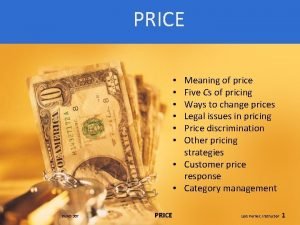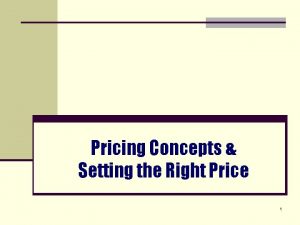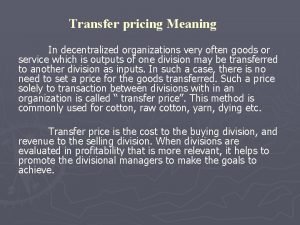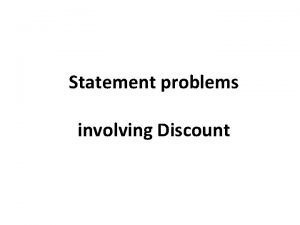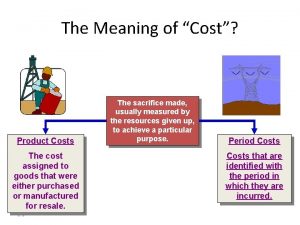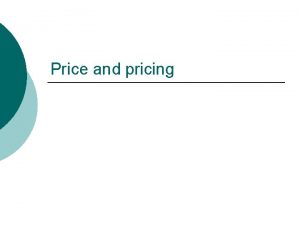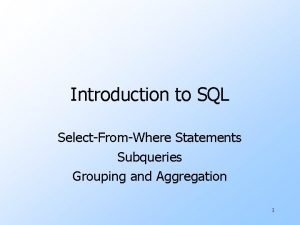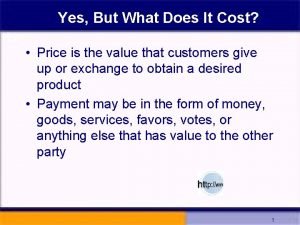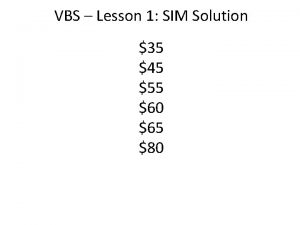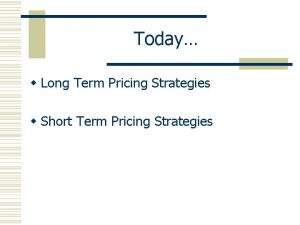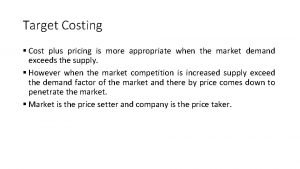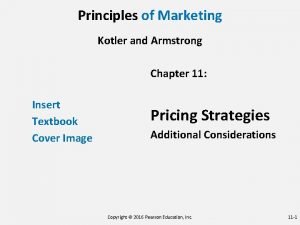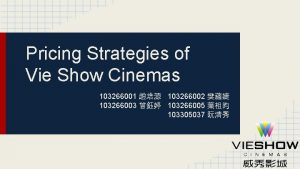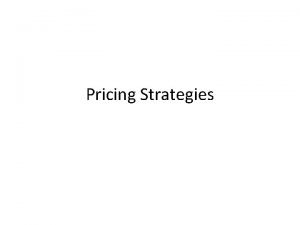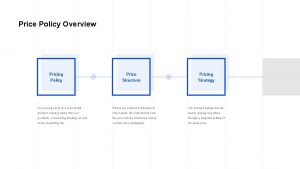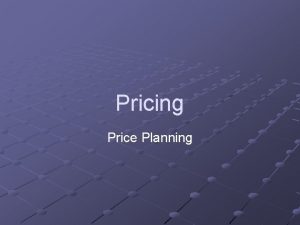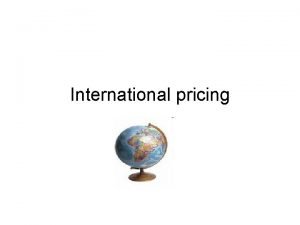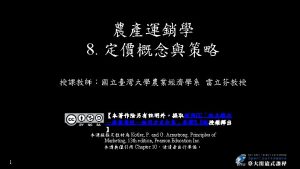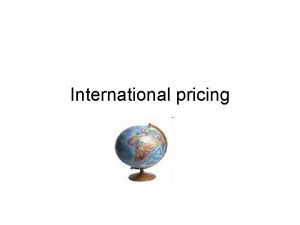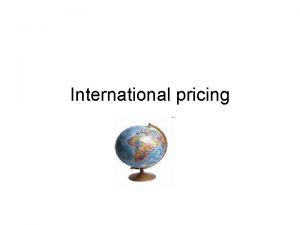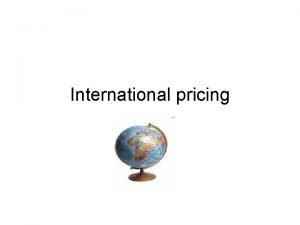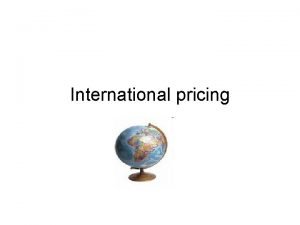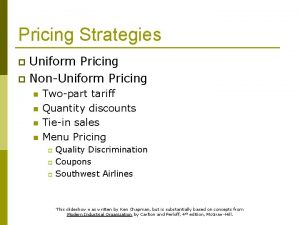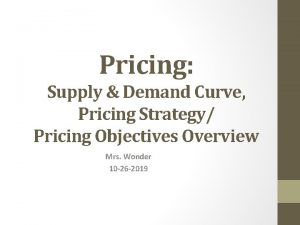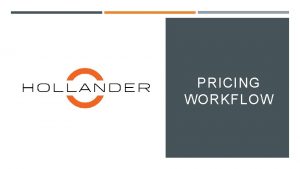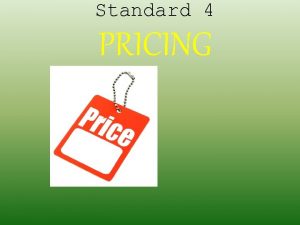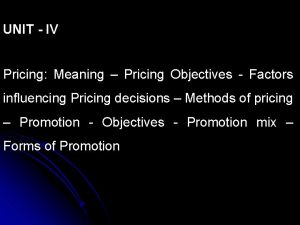PRICE Meaning of price Five Cs of pricing






































- Slides: 38

PRICE Meaning of price Five Cs of pricing Ways to change prices Legal issues in pricing Price discrimination Other pricing strategies • Customer price response • Category management • • • BUAD 307 PRICE Lars Perner, Instructor 1

LEARNING OBJECTIVES • Identify advantages and disadvantages of pricing approaches under different circumstances • Identify illegal and potentially unethical pricing practices • Identify differences in perspectives to price between marketing professionals and economists • Identify likely customer response to different price offerings • Identify degrees of product substitutability and implications for category management BUAD 307 PRICE Lars Perner, Instructor 2

PRICE • • Meaning of price Five Cs of pricing Ways to change prices Legal issues in pricing Price discrimination Other pricing strategies Customer price response Category management BUAD 307 PRICE Lars Perner, Instructor 3

One View of Price • Price = • Ways to change the price: resources given up – Sticker price (dollar amount) – Quantity—same sticker price but lesser quantity – Quality—use of lower cost materials —e. g. , “gooeye” stuff rather than chocolate in candy – Terms ___________________ goods received • E. g. , 12 bullets for $6. 00 = $0. 50 per bullet • E. g. , support, accessories, payment terms, delivery BUAD 307 PRICE Lars Perner, Instructor 4

Examples of Price Changes • Cereal manufacturers put a smaller quantity of cereal in boxes • Paper towel manufacturers use fewer sheets per roll • Candy bar manufacturers use more “gooey” stuff (instead of costlier chocolate) • Some hamburger chains stop using tomato slices when prices spike • Software makers now charge for service (900 numbers or per minute charge) but, adjusted for inflation, sticker prices are lower in this later stage of the life cycle • Most airlines now charge for checking baggage and domestic meals BUAD 307 PRICE Lars Perner, Instructor 5

Views of Consumers and Price Response • Marketing • Economics – Consumer knowledge of product quality and prices is imperfect – Due to imperfect information, a higher price may sometimes be used by consumers to infer greater quality – Assumed to have perfect information about • Quality of all brands • Prices of each brand at all locations – Elasticity: A “downsloping” demand curve means that a higher quantity will be demanded when the price is reduced BUAD 307 (Research suggests that actual product quality as rated by Consumer Reports accounts for about 25% of product price differences among brands) PRICE Lars Perner, Instructor 6

Five Cs of Pricing • Company objectives— note that these may not be realistic! – Target profit pricing – Premium pricing – Profit maximization (optimal price structure, if known) • Competition – Competitive parity – Status quo pricing – Customer perceived value – Demand curve pricing (individual and market price elasticity) – Prestige pricing • Costs (note that your costs may not equal those of competitors or value to customers!) – Types: • Channel members – Authorized sellers – “Gray” markets (diversion) BUAD 307 • Customers PRICE • Variable • Fixed – Break-even quantity – Returns by product category and customer value—may need to take smaller margins on some products Lars Perner, Instructor 7

Does the consumer have the means (income and/or wealth) to pay for premium products across product categories? NO Limited potential for premium priced sales NO YES Is the customer willing to pay a premium price across product categories? YES Better potential for premium priced sales Note: Some customers may “trade up” in select product categories of special personal importance. BUAD 307 PRICE Lars Perner, Instructor 8

Cost and Pricing • Your cost may not equal that of competitors or reflect value to customers – In some cases, larger margins can be sought. In others, one will have to settle for smaller ones. May need to offer unprofitable products to be credible as a full line supplier. – In some cases, a product is sold at little if any profit to make larger products on accessories and “consumables”—e. g. , • Amazon Kindle e-books and other digital content • Printers cartridges and toner • In the long run, you will generally need to cover at least your costs across products produced • However, meeting cost should generally used as a test only after price has set based on market conditions. Merely having higher costs does not allow a firm to charge higher than market prices. BUAD 307 PRICE Lars Perner, Instructor 9

Supply, Demand, and Quantities Supplied and Demanded BUAD 307 PRICE Lars Perner, Instructor 10

Supply, Demand, and Quantities Supplied and Demanded • Supply: The “schedule, ” or “curve, ” of quantities supplied by the sellers at various prices offered by buyers – Tends to increase with price—a greater quantity will be supplied at a higher level of incentive to produce – Demand: The “schedule, ” or “curve, ” of quantities demanded by the buyers at various prices offered by sellers – Tends to decrease with price—the marginal value of additional quantity tends to decline with a greater price – Occasionally, higher prices may lead to higher quantity demanded due to a possible “signal” of quality BUAD 307 PRICE Demand curve: Smaller quantity at higher price Supply curve: Greater quantity at higher price Lars Perner, Instructor 11

Equilibrium • The intersection of the supply and demand curves—neither side is interested in buying or selling more or less given the resultant market prices Equilibrium – This equilibrium may be temporary and may change once the market changes— e. g. , • Changes in the availability change in supply • Changes in cost of production change in supply • Availability of new substitutes change in demand BUAD 307 PRICE Lars Perner, Instructor 12

Quantities Supplied and Demanded • Quantity supplied: The quantity that will be supplied (sold) by sellers at a given price point • Quantity demanded: The quantity that will be demanded (bought) by buyers at a given price point Equilibrium price Equilibrium quantity supplied and demanded BUAD 307 PRICE Lars Perner, Instructor 13

Price Discrimination • Explicit • Implicit – No outright rule, but – Only some customers are discounted deal is eligible for special pricing unattractive to some —e. g. , customers • Student discounts on software • Senior citizen discounts • Geographic: Only customers in the 900**-935** zip code areas are eligible for discount Disneyland Admission BUAD 307 PRICE • Airlines: Saturday night stay-over or advance purchase requirement • Daily special meal— one cheaper meal but no choice • Periodic discounting (products going on and off sale) Lars Perner, Instructor 14

“Upselling” • An attempt to get the customer to upgrade to a more expensive option one a lower priced one has been selected—e. g. , – Offer to upgrade to “Economy Plus” status on flights – Extra charge for preferred seat (e. g. , aisle, extra space, front of plane) – Car rental upgrade BUAD 307 PRICE Lars Perner, Instructor 15

Add-on Options • • Collision waiver on rental cars Flight insurance Extended warranty options “VIP package” BUAD 307 PRICE Lars Perner, Instructor 16

Pricing New Products • Skimming: high intro price ---> take advantage of price insensitive consumers – Initial sales volumes will be limited – High margins are likely to encourage competitors to enter and undercut your price – More effective when competitors cannot match your new offerings in the near future (e. g. , newest Intel chips) • Penetration pricing: low intro price – Will usually result in higher sales volumes – Sales happen faster (less incentive to wait) – Competitors are less likely to enter and offer lower prices BUAD 307 PRICE Lars Perner, Instructor 17

Skimming Pricing 350 Most price insensitive customers 300 P 1 250 Only a limited quantity is sold at the highest price P 2 Second most price insensitive customers 200 150 P 3 100 50 Q 1 0 0 200 Q 3 Q 2 400 600 800 1000 1200 The product is introduced at a high price, P 1. Very few customers—only the least price sensitive ones—buy at this price. When the price is later lowered to P 2 and then to P 3, other customers who value the product less will start to buy. The least price sensitive customers pay a premium for quick access to the new product. BUAD 307 PRICE Lars Perner, Instructor 18

Penetration Pricing 350 300 Some customers would be willing to pay a higher price than what they actually pay under this low introductory price(area between the green curve and the red line) A large quantity is sold early on due to the lower price 250 P 1 200 150 100 50 Q 1 0 0 200 400 600 800 1000 1200 The product is immediately introduced at a relatively low price (and will continue to be sold at a low price. ) The seller sacrifices the higher margins that would have resulted from selling to some customers at a higher price, but, in return gains immediate sales. Fewer competitors are attracted into the market since the apparent profits are not as high. Because of economies of scale and experience curves—the tendency of production costs to decline with the cumulative production—costs are reduced. BUAD 307 PRICE Lars Perner, Instructor 19

Some Approaches to Pricing, Part I • Cost-plus: Add fixed percentage markup (in practice, this does not necessarily reflect the actual value to your customers) • Buyer-based • Perceived value • Going-rate (matching the market price) • Supply and demand results in an equilibrium price for product categories with limited differentiation BUAD 307 PRICE Preferred method when an offering is differentiated from those of competitors Lars Perner, Instructor 20

Some Approaches to Pricing, Part II • Everyday Low Price (EDLP)—low everyday prices but no sales (difficult in practice since manufacturers often pay for lower sale prices) • High/Low Pricing: Higher regular prices with periodic sales BUAD 307 PRICE Lars Perner, Instructor 21

Legal Issues • Banned by Federal law: – Discrimination in prices paid by firms which compete against each other unless supported by evidence of cost savings • OK to charge restaurants more than grocery stores • Can only charge Wal-Mart less than Joe’s Supermarket if volume savings can be proven—and the price difference must be no greater than the actual provable cost savings. BUAD 307 PRICE • Banned by some state laws: – Gender discrimination (e. g. , charging more for dry cleaning women’s clothes than men’s clothes) – Discrimination between consumers in general • Senior citizen discounts are explicitly permitted in California Lars Perner, Instructor 22

More Legal Issues • Federal and State bans on: – Collusion (coordinating or even discussing prices with competitors) – Tying: Requiring the customer to buy one product to be allowed to buy another – Predation (offering temporary prices below cost of production to drive competitors out of business and then raising prices) • In general, fully absorbed average cost must be used—cannot use marginal cost – Using monopoly power in one market to “subsidize” new market BUAD 307 PRICE Lars Perner, Instructor 23

Price Maintenance • In 2007, the U. S. Supreme Court reversed the longstanding ban on explicit agreements between manufacturers that the branded product would not be sold below an agreed upon “floor” price – – Although setting minimum retail prices for a brand reduces intrabrand competition (competition between different retailers selling the brand), some believe that minimum prices may encourage investment in service and brand building to the extent that competition between brands increases (inter-brand competition) Manufacturers generally cannot enforce minimum price agreements on existing inventory, but they can “cut off” offending retailers • “Gray market” goods: Retailers in the U. S. generally have an absolute right to sell products that they have bought legally at a price lower than the suggested retail price. – BUAD 307 Diversion: Legitimate retailers buy up extra quantity to be resold to unauthorized dealers and/or geographic shipment. (More details will be given under distribution). PRICE Lars Perner, Instructor 24

Intra- vs. Interbrand Competition • Intrabrand Competition: Competition among sellers of the same brand (e. g. , Nike Store, Target, and Sports Chalet all sell Nike shoes) – Often focused on price, although retailers can compete on service as well • Interbrand Competition: Competition between different brands (e. g. , Nike, Rebok, Adidas) – Both manufacturers and retailers may be involved – Price is one factor – If manufacturers are able to guarantee retailers a certain margin since other retailers will not undersell them, retailers may be motivated to invest in additional services for customers (e. g. , salesperson training, in-store repair facilities) BUAD 307 PRICE Lars Perner, Instructor 25

Tying vs. Price Bundling • Tying: Requiring a customer to buy a less popular item in order to be allowed to buy something more popular – Generally not legal – Involves effective use of monopoly power • Price bundling: Offering two complementary items at a lower price than the sum of the individual items (more likely to be equal) – E. g. , hotel alone is $185 per night and care rental is $75 per day, but a special deal is offered of both for $225 per day ($35 saving) – May involve a third party combining offerings of two partner firms (e. g. , hotel and car rental service) BUAD 307 PRICE Lars Perner, Instructor 26

REMINDER INCOME ≠ WILLINGNESS TO SPEND! Income or wealth is a necessary, but not sufficient, condition for buying certain high price items. Some customers may value one product category particularly highly. Many consumers live beyond their means, running up large debts. It generally makes more sense to segment on price sensitivity than on income or wealth BUAD 307 PRICE Lars Perner, Instructor 27

Price Adjustments For and Discrimination Among Consumers • Cars: List price – manufacturer discounts and rebates – dealer discount • Tuition: List price – scholarships – financial aid BUAD 307 PRICE Lars Perner, Instructor 28

Introductory Effects • In an experiment, laundry detergent was introduced at $0. 49 in one condition and $0. 79 in another • After 8 weeks, price was raised to $0. 79 for low price intro condition • There were higher cumulative sales in high price intro Introducing a product at a low price without clearly indicating that this is a temporary price to encourage trial will likely create an image among customers that this is a “low priced” brand. Coupons may help avoid sending this signal. BUAD 307 PRICE Lars Perner, Instructor 29

Consumer Price Awareness • A survey revealed of consumers who had just selected a product suggested: • Avg. time spent before departing from product area: 12 seconds • Avg. no. of products inspected: 1. 2; only 21. 6% claimed to check price of nonchosen brand • 55. 6% could state price of just chosen product within 5% BUAD 307 PRICE Lars Perner, Instructor 30

Consumer Reference Prices • Consumers typically have some expectation of what they will pay. This is based on: • Previous experience • Reasoning and “gut” feelings • Perceived fairness • Two kinds of reference prices: • Internal: Based on consumer’s memory. • External: Based on environment (e. g. , signs, other products in the store) BUAD 307 PRICE Lars Perner, Instructor 31

Internal Reference Prices • Consumers tend to develop some memory of prices of frequently purchased items ---> to make store prices look low, you may want to price especially salient products lower • More knowledgeable consumers typically have tighter price range expectations • Reference prices are constantly updated to some extent, but are hard to change upwards--certain unreasonable “stimuli” (prices) may be rejected as unreal • Consumer reference prices tend to be lower than actual prices ---> “sticker shock” BUAD 307 PRICE Lars Perner, Instructor 32

External Reference Prices • Reference prices provided by seller or environment • E. g. , • “MSRP $3. 99; our price $2. 49” • “Sold elsewhere for $20. 00; our price $14. 99” • “Was $100. 00; now $69. 95” BUAD 307 PRICE Lars Perner, Instructor 33

The Promotion Signal • A segment of consumers will respond to negligible discounts--e. g. , “SALE! $3. 95 (Was $4. 02). • However, merely placing a sign “EVERYDAY LOW PRICE” randomly also increased sales of affected products. BUAD 307 PRICE Lars Perner, Instructor 34

Other Manufacturers’ “Suggested” Retail Prices (MSRPs) • U. S. manufacturers often put an exorbitantly high “suggested” price on a product so that even full service retailers can look good by selling below the MSRP • In some EU countries, selling below the MSRP is generally not legal— manufacturers must therefore be careful not to “recommend” excessive prices BUAD 307 PRICE Lars Perner, Instructor 35

Odd/Even Pricing--Does It Have an Impact? • Theory: $3. 00 is rounded to $3. 00 while $2. 99 is rounded to “$2. 00 plus change” • Reality: Studies in U. S. have found a small impact (the price elasticity is greater going from $5. 00 to $4. 95 than from $5. 10 to $5. 05). This is a very small impact. Sales increase only a slight amount. The loss of the extra cents may cancel out profit from increased quantity sales. • Note that odd pricing may signal receiving a bargain, which may nor may not be compatible with the desired product image • Odd pricing has typically been used by tradition (initially implemented to force cashiers to ring up purchases in order to give change). BUAD 307 PRICE Lars Perner, Instructor 36

REMINDER • The increase in sales that results from using “odd” prices is tiny! BUAD 307 PRICE Lars Perner, Instructor 37

Category Management • Pricing and promotion decisions are made with consideration of their impact on sales of other products that are potential substitutes – E. g. , most of the increase in sales of Coca Cola that would result from a discount on or other promotion of that brand would likely come at the result of sales of Pepsi, other soft drinks brands, juices, and bottled water—the total increase in category sales will be much smaller • Some product categories have greater potential to increase total category sales if one brand is put on sale (e. g. , total consumption of snacks can increase) BUAD 307 PRICE Lars Perner, Instructor 38
 Ibang katawagan ng price ceiling
Ibang katawagan ng price ceiling The 5 cs of pricing
The 5 cs of pricing And now with gleams of half-extinguished thought
And now with gleams of half-extinguished thought Five of five
Five of five Five elements and five senses
Five elements and five senses Drum and colors macbeth
Drum and colors macbeth Product mix pricing strategies
Product mix pricing strategies Predatory pricing meaning
Predatory pricing meaning Transfer pricing meaning
Transfer pricing meaning Marked price-selling price=
Marked price-selling price= Hire purchase and installment system difference
Hire purchase and installment system difference Bhel eprocurement
Bhel eprocurement Price discovery and price determination
Price discovery and price determination The that cost
The that cost Price structure meaning
Price structure meaning Define price gouging
Define price gouging Captive pricing
Captive pricing Stadium staffing math quiz answers
Stadium staffing math quiz answers Ltl blanket pricing
Ltl blanket pricing Transfer pricing example
Transfer pricing example Short term pricing strategies
Short term pricing strategies Nature of price
Nature of price Federico bandi
Federico bandi Arbitrage pricing theory model
Arbitrage pricing theory model Tesla pricing strategy
Tesla pricing strategy Tele message
Tele message Cost plus vs target costing
Cost plus vs target costing Sphereshield pricing
Sphereshield pricing Non physical fences example
Non physical fences example System center pricing
System center pricing Serena deployment automation pricing
Serena deployment automation pricing Biztalk360 pricing
Biztalk360 pricing Balabit vs cyberark
Balabit vs cyberark What is price matching
What is price matching Marketing chapter 11
Marketing chapter 11 Going rate pricing example
Going rate pricing example Popcorn pricing strategy
Popcorn pricing strategy Captive-product pricing
Captive-product pricing Chapter 26 pricing strategies answer key
Chapter 26 pricing strategies answer key

